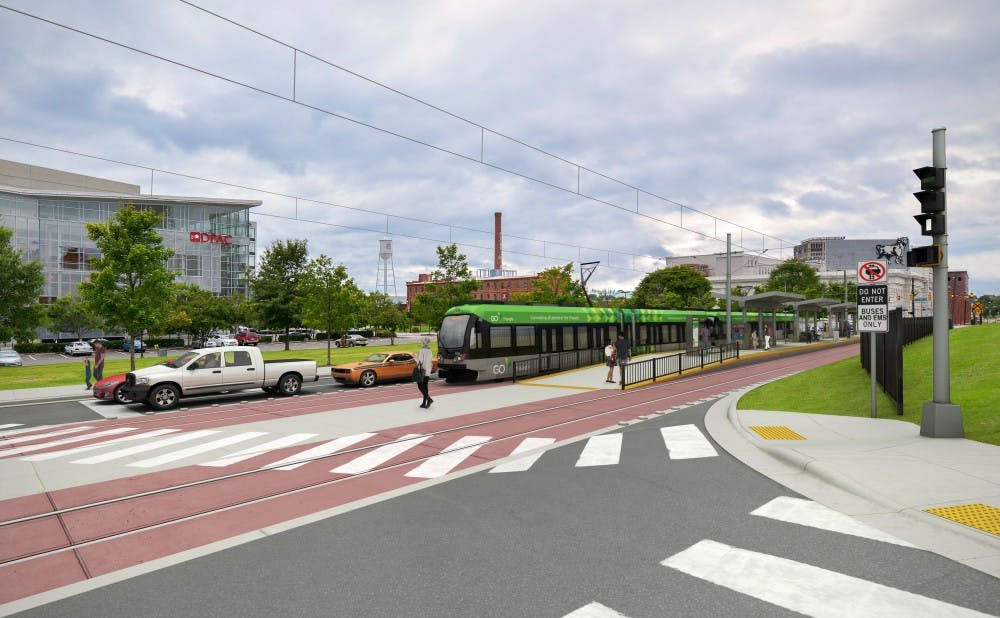A dim outlook for light rail investment in President Donald Trump’s infrastructure plan could be a hurdle for a project looking to bring light rail to the Triangle.
The Durham-Orange light rail project—a 17.7 mile route that would connect Duke, North Carolina Central University and the University of North Carolina at Chapel Hill—is currently in the engineering phase. This means that the basics of the route are locked in, as is the request for $1.25 billion of funding—constituting one half of the $2.5 billion project. The plan received approval from local authorities last May—when the cost was estimated at $3.3 billion—taking it to the federal stage for review. Despite the president’s infrastructure plan, Durham Mayor Steve Schewel still expressed confidence that the project will secure federal funding.
“There are too many people with too many interests in these transit projects around the country for that to prevail,” he said.
Schewel noted he is advocating for the U.S. House of Representatives and Senate to continue, as they have done in the past, to fund light rail investments at its usual level, despite Trump zeroing in on light rail investments in his proposed budget.
He added that the project is aiming to score around $200 million in state funding and if it can do so, Schewel said he believes that will help in securing federal funding. The project will find out how much it has received in the next several months.
The need to persuade state and federal government officials to contribute funding has caused Schewel and the Research Triangle Regional Public Transportation Authority (GoTriangle) to meet with legislators at both levels of government in order to garner support for the project.
“We need to make sure that our congressional delegation is supportive of continuing funding for transit,” Schewel said.
Schewel explained that transit investments were one of the main themes brought up during the recent national conference of mayors in Washington. He said the cohort of mayors met with the U.S. special assistant to the secretary of transportation and Sen. Thom Tillis (R-N.C.) to garner support for the project.
GoTriangle is also in constant contact with federal and state transportation officials throughout the planning process to advocate for the project, said Patrick McDonough, manager of planning and transit-oriented development for GoTriangle.
In addition to working closely with federal and state officials to secure funding, Schewel and McDonough indicated that the project team is collaborating with Duke administrators to design the portion of the track that would be along Erwin Road, which would serve riders from the University and the Hospital.
“Duke is an absolutely critical partner on the project,” McDonough said.
Schewel noted that he had been in discussions with President Vincent Price and Eugene Washington, president and CEO of Duke University Health System. He added that the city, GoTriangle and the University are collaborating in order to configure the best design for the portion of the track on Erwin Road around the hospital, Schewel said.
The team must consider that emergency vehicles need sufficient room to turn into the emergency room. This requires considering where the system should go aerial, and Schewel noted that there are also cost considerations when going aerial.
Although the locations of the stops are set, McDonough said that other aspects of what the track will look and feel like are still topics of discussion between GoTriangle’s engineering and design teams. He noted that the regional transit authority hosted a meeting in Durham to get community input on what design themes the track should embody and that some ideas which came up were 'grit' and 'Black Wall Street.' The team will host a similar second meeting in Chapel Hill next week.
McDonough added that the team is also considering locations for bike paths that would run alongside parts of the track so some riders could have the ability to bike to the light rail instead of parking and riding.
Since there are several years from the project’s inception and planning phases to its completion, McDonough noted that it is possible that some aspects of the project could be modified to better match people’s parking habits, with the potential for changes brought by the introduction of autonomous vehicles. Despite the potential for some evolution of the project, he pointed out that its core will remain strong over the years because of the tracks’ proximity to two Level I trauma centers and three local universities.
“We have three anchors that are not going anywhere,” McDonough said.
Get The Chronicle straight to your inbox
Signup for our weekly newsletter. Cancel at any time.

